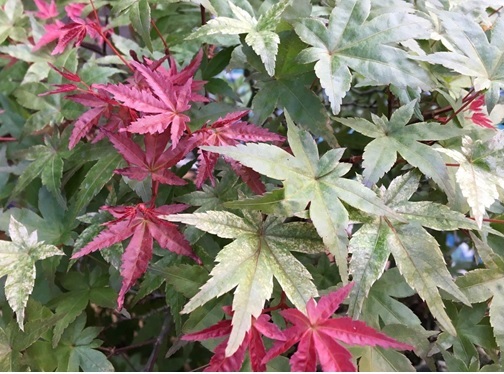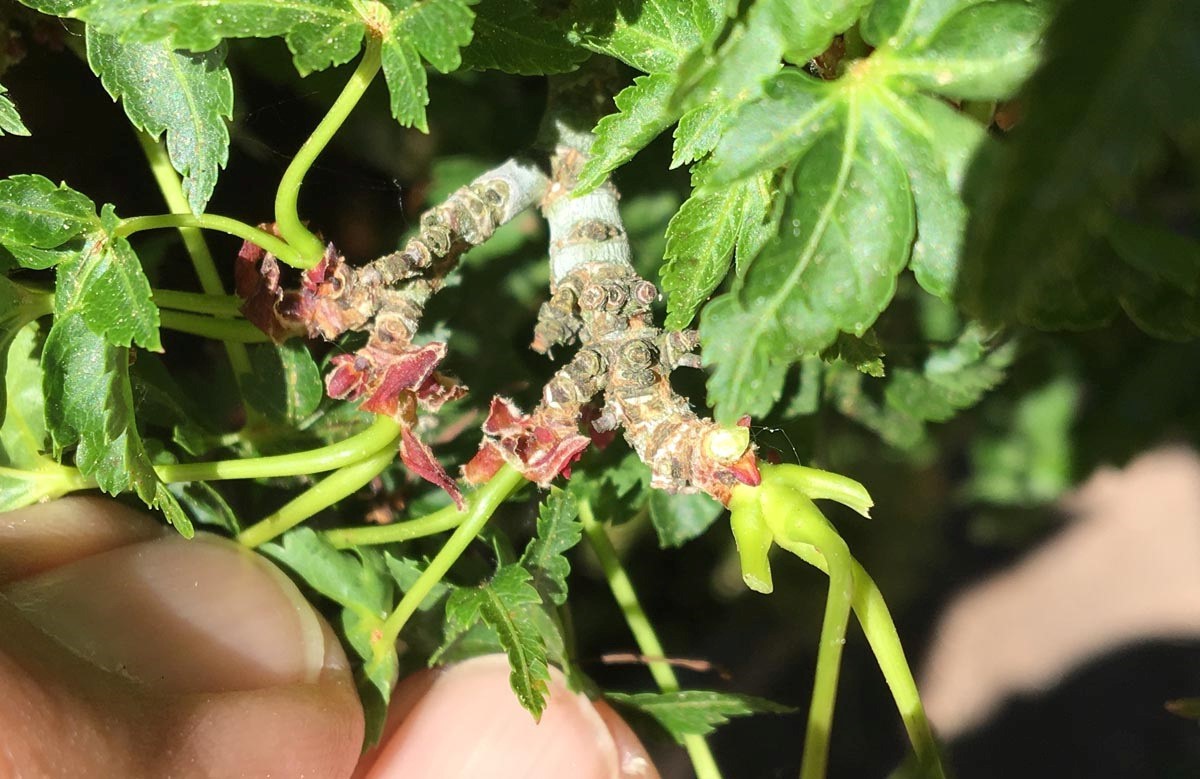There will always, always, be a place for a Japanese Maple on my bench. If I could have but one tree, that might be it. It would be a tough battle though, with pines. The varieties and types of maples abound, and there are lots of techniques out there for handling them. The goal for refining any Japanese Maple is to create a light and airy feeling full of grace and suppleness, even when growing a rather masculine or stumpy shohin, the branches are still delicate. These trees naturally grow in the mountains of Japan. We have our own vine maples which grow from the sea to the cascade crest and they will help inform the graceful shape of a maple. I was recently in downtown Lake Oswego and saw perhaps the largest specimen of Japanese Maple that I have ever seen with a trunk diameter probably over 24 inches. It was like unto a towering oak. The reason I mention it is to say that we can find substantial examples of mature trees to observe and learn from.
I have several varieties of Japanese maples. Without a doubt, my favorite is just the plain, standard species with its delicate and lovely green leaves. I have about a dozen from shohin to medium and large size trees that I am growing from scratch. Other varieties include a Shishigashira (Lion’s Mane) that was begun by Edris Stryker, and a red Deshojo developed by Anne Spencer. Lastly, I have a pair of Okushimos that were started from cuttings. All of these trees have their pluses and minuses, and their own unique growth habits. So that is the subject of this month’s Branch Tips.
The standard operating procedure for Japanese Maple care when I first started, that was touted in all of the books, was to entirely defoliate the tree in late spring or early summer. The goal was to create a second flush of growth with shorter inter-nodes and smaller leaves. There are several problems with this technique. First of all, if your tree is not strong enough, you might kill it, or at the least lose some branches. Enough said there. Secondly, if you have pencil size trunks and you perform this technique, they will remain pencil size indefinitely. No one ever told me to do it AFTER you get it to the size you want. This is a maintenance technique, not a development one. And thirdly, you risk burning the trunk or branches and doing permanent damage to the tree. So, entire defoliation is a bad idea. I can’t think of a situation where I would recommend it.
Then along came Boon and offered a big upgrade to this technique. Instead of removing all of the leaves, remove one leaf from every pair across the tree, cutting across the petiole. You can leave both leaves on weak interior shoots. If you have particularly strong leaves, you can cut the outer portions off to reduce the solar surface area. The effect is twofold; first, since you have only removed half of the foliage, the tree is not forced into making new shoots and is happy to live the remainder of the season with what it has, and secondly, it reduces the amount of sugars and starches being produced. This keeps the branches from thickening too much and becoming coarse, preserving the light and airy feeling that we cherish so much in maples. Be sure to be aware that although all maples have an opposite branching habit, they alternate in orientation. This is to say that one set of buds aligns vertically, the next set horizontally. Ideally, they would all align laterally, so keep this in mind when pruning. If the inter-nodes are really short, then you have some options to choose the orientation that you need. This has become my de facto standard technique for maintaining already developed maples, and many other deciduous trees as well.
So this technique is all well and good for regular, species maples, but the varieties that I mentioned above present some unique growth habits that require us to alter our technique. The general idea is to create a short inter-node (recalling Dennis Vojtilla’s rule of thumb – about ¾ to 1 inch) and we do this by pruning back to the first set of leaves on a maple. Since they produce opposite pairs of leaves, there is always a fork or bifurcation at any node we prune to. When we come to a species like Shishigashira, which grows very slowly, the nodes may only be 1/8 inch apart, or virtually absent. If we continually cut back to the first node, we get nowhere, and the nodes are too close. Here we do the opposite of all of your bonsai training. We cut the leaves on the inner shoots closest to the trunk and leave the pair of leaves at the point where we want the next set of branching, which is most often the very last pair. This can be tedious work but leads to a ramification that develops more quickly and is more maintainable in the long run.
Our next guest on the turntable is the Deshojo variety. This is an older cultivar and has beautiful deep coral foliage in the spring as shoots emerge that contrasts beautifully with the mature white bark. There is nothing quite like it. Alas, the foliage the rest of the year causes one to wonder why you are growing it in the first place. It’s sort of a mottled, drab, greenish affair. It also happens to be a fairly weak grower, like many of the special varieties. It often has droopy foliage and only a few elongating shoots. For this specimen, I still remove every other leaf, but I leave more leaves in the weaker areas, like the lower branches and interior shoots. I wire up the weak shoots so that they can get more light and gain enough strength to hold themselves up and I make sure to not remove any leaves, except to shorten the overall length. This process has really improved the overall health and strength of the tree.
I can detect no graft union in either the Deshojo, or Shishi but they are often propagated by this method. Most special varieties do not propagate true from seed, and they often have a weaker growth habit necessitating the need for the graft onto the stronger, species stock. An exceptions to the rule are the two Okushimo trees that I have been growing, like forever. Both were from a set of about ten, two-year old rooted cuttings by Wright’s Nursery, which is no longer in existence. Two each of five species. I won them in a raffle at my very first convention, in 1990, before I was even a member of BSOP. Maples are difficult to root from cuttings, so these are very much an anomaly. That is borne out by the fact that the other eight trees died within two years. That may also reflect in my lack of skill, but I did keep everything else alive. These two grow really slowly. I had them in the ground for several years and they barely grew. I gave one to my grandfather and it passed back to me when he died. They have the strangest leaves, which are not to everyone’s taste. But I like ‘em. Since they were grown from cuttings, the roots emerged on just one side, so I have in-arch grafted species roots to fill in the bases. In all that time, these trees are still only an inch and half in diameter. They are growing stronger than ever though. They really want to send all the energy to just a few shoots, so I use pruning to redirect that strength more evenly.
Lastly, I would like to mention our own native Vine Maple. I love these guys too. These are the closest relatives to Japanese Maples outside of Japan. Try the same techniques, but a few words of caution. They prefer dappled sunlight in the summer. They naturally grow in the margins of the forest to deeper shade. I keep mine in full sun in the spring until sometime in June, then it’s under cover. These trees are coarser than their Japanese cousins, so they tend to get very thick and long inter-nodes if allowed to rage on.
When I prune in late spring to early summer, I sometimes cut off entire nodes because they have gotten too long or heavy. I take off every other leaf on the rest. During this pruning I make sure to space out the remaining leaves such that there is equal distribution to light. This requires a little thinking ahead and watching the area as much as an individual shoot. There is also a large discrepancy in leaf size, so I often resort to cutting off the exterior leaf mass to make them more equal.
I even showed this tree in the fall after cutting the leaves down to size but matching the overall leaf shape with five points. No one noticed! In situations where the whole shoot has been pruned, the tree responds with new shoots. In the long distant past when I entirely defoliated the vine maples, they just sat there the rest of the season and waited until the next spring to grow again. Be aware of that thought but temper it with the fact that I did not fertilize much and they were very small trees growing on a rock – not many resources. Now that the tree is in refinement, that drastic technique is not needed.
So jump in and prune your maples to direct development and protect them a bit after you do so. Stay cool.
Elongating species Japanese Maple in development. Let it grow!
Okushimo. These leaves are certainly unique
Deshojo Maple. Note the red leaves, just like spring growth, that emerged after flush pruning.
Shishigashira before pruning. Note the extremely short internodes – really isn’t one.
Shishi after pruning. We cut the leaves nearest the trunk. Since we have another branch nearby, we eliminate the weak shoot. For scale, see my fingers!
Vine Maple. The overall size of the larger leaf has been reduced to match the smaller leaf.






